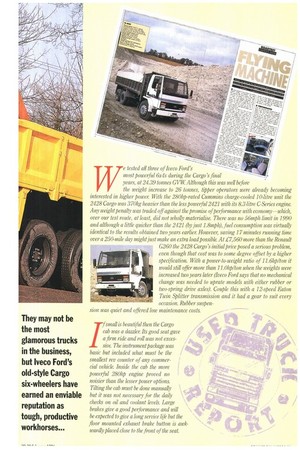.y e tested all three of Iveco Ford's
Page 23

If you've noticed an error in this article please click here to report it so we can fix it.
, W most powerful 6x4s during the Cargo's final ears, at 24.39 tonnes GVW. Although this was well before the weight increase to 26 tonnes, tipper operators were already becoming interested in higher power With the 280hp-rated Cummins charge-cooled 10-litre unit the 2428 Cargo was 370kg heavier than the less powerful 2421 with its 8.3-litre C-Series engine. Any weight penalty was traded off against the promise of performance with economy—which, over our test route, at least, did not wholly materialise. There was no 56mph limit in 1990 and although a little quicker than the 2421 (by just 1.8mph), fuel consumption was virtually identical to the results obtained two years earlier However, saving 17 minutes running time over a 250-mile day might just make an extra load possible. At17,560 more than the Renault G260 the 2428 Cargo's initial price posed a serious problem, even though that cost was to some degree offset by a higher specification. With a power-to-weight ratio of 11.6hP/ton it would still offer more than I 1.0hp/ton when the weights were increased two years later (Iveco Ford says that no mechanical change was needed to uprate models with either rubber or two-spring drive axles). Couple this with a 12-speed Eaton Twin Splitter transmission and it had a gear to suit every occasion. Rubber suspen
sion was quiet and offered low maintenance costs.




































































































